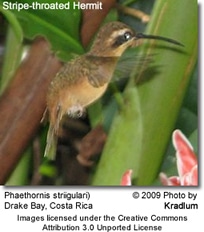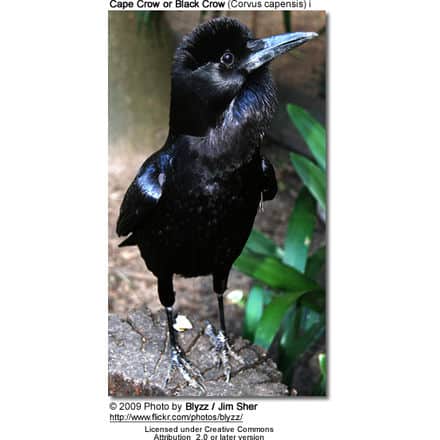Stripe-throated Hermit
The Stripe-throated Hermits (Phaethornis striigularis) are hummingbirds found in southern Mexico, Central America south to north-western South America. They are fairly common within their range.

Description
Stripe-throated Hermits are among the smaller species of hermits, measuring 3½-4 in (9-10 cm) in length – including the tail; and they weigh between 0.07 – 0.11 oz (2 – 3 g).
Their upper plumage is mostly a dull iridescent green; except for the pale-rufous colored rump. The underside and flanks are buff and the central under plumage and throat are pale greyish-brown, with small dark streaks on the throat.
They have a blackish face mask with a whitish buff supercilium (line above the eye) above it and a whitish-buff malar (cheek stripe) below the face mask. The flight feathers and tail are blackish.
As in most other hermits, it has a long, decurved bill. The bill is black, except for the yellow basal half of the lower beak.
Males and females look alike.
Juveniles have a rufous-colored back.
Distribution and ecology
The Stripe-throated Hermits occur naturally in southern Mexico – north-eastern Oaxaca and southern Veracruz east to southern Quintana Roo, Belize, north-eastern Guatemala, northern and eastern Honduras, Nicaragua, Costa Rica, Panama, western, central, and northern Colombia (where it mostly occurs in the Pacific lowlands and the Magdalena valley region), western Ecuador (south to El Oro) and north-eastern Venezuela (where it occurs on both slopes of the Andes and northern mountains).
They are mostly resident (non-migratory), but some local movements may occur in response to differing flowering seasons.
They are typically found in humid regions, but may occur in drier, deciduous habitats, such is the case in Ecuador. They occur in lowlands and foothills up to an altitude of 5900 ft (1800 m). They inhabit forests, woodland areas, clearings, thickets, and gardens.
Song / Vocalizations
The male’s song is described as high-pitched, squeaky, and monotonous.
Nesting / Breeding
Stripe-throated Hermits form leks (= competitive mating displays) during the breeding season to attract females. Their display may entail wiggling their tails and singing. Willing females will enter the area for the purpose of choosing a male for mating. Oftentimes she will choose the best singer.
Hummingbirds in general are solitary and neither live nor migrate in flocks; and there is no pair bond for this species – the male’s only involvement in the reproductive process is the actual mating with the female.
He will separate from the female immediately after copulation. One male may mate with several females. In all likelihood, the female will also mate with several males. The males do not participate in choosing the nest location, building the nest, or raising the chicks.
The female Hermit is alone responsible for building a dangling nest with a “tail” below it. The nest is often near a stream or waterfall. It is constructed out of plant fibers woven together and green moss on the outside for camouflage in a protected location.
She lines the nest with soft plant fibers, animal hair, and feathers down, and strengthens the structure with spider webbing and other sticky material, giving it an elastic quality to allow it to stretch to double its size as the chicks grow and need more room.
The average clutch consists of two white eggs, which she incubates alone for 15 – 16 days, while the male defends his territory and the flowers he feeds on (although hermit males tend to be less aggressive than the males of other hummingbird species). The young are born blind, immobile, and without any down.
The female alone protects and feeds the chicks with regurgitated food (mostly partially digested insects since nectar is an insufficient source of protein for the growing chicks). The female pushes the food down the chicks’ throats with her long bill directly into their stomachs.
As is the case with other hummingbird species, the chicks are brooded only the first week or two and are left alone even on cooler nights after about 12 days – probably due to the small nest size. The chicks leave the nest when they are about 20 days old.
Diet / Feeding
Stripe-throated Hermits primarily feed on flower nectar taken from a variety of brightly colored, scented small flowers of trees, herbs, shrubs, and epiphytes. In general, they favor flowers with the highest sugar content (often red-colored and tubular-shaped).
Hermits are “trap-line feeders”. As such they frequent plants along a long route (in this case up to 0.6 miles or 1 km). This differentiates them from most other hummingbird species which generally maintain feeding territories in areas that contain their favorite plants (those that contain flowers with high-energy nectar), and they aggressively protect those areas.
Hermits use their long, extendible, straw-like tongues to retrieve the nectar while hovering with their tails cocked upward as they are licking at the nectar up to 13 times per second. Sometimes they may be seen hanging on the flower while feeding. They have also been observed piercing the base of flowers to get nectar that otherwise would be out of reach.
Many native and cultivated plants on whose flowers these birds feed heavily rely on them for pollination. The mostly tubular-shaped flowers exclude most bees and butterflies from feeding on them and, subsequently, from pollinating the plants.
They may also visit local hummingbird feeders for some sugar water, or drink out of bird baths or water fountains where they will either hover and sip water as it runs over the edge; or they will perch on the edge and drink – like all the other birds; however, they only remain still for a short moment.
They also take some small spiders and insects – important sources of protein particularly needed during the breeding season to ensure the proper development of their young. Insects are often caught in flight (hawking); snatched off leaves or branches, or taken from spider webs. A nesting female can capture up to 2,000 insects a day.
Males establish feeding territories, where they aggressively chase away other males as well as large insects – such as bumblebees and hawk moths – that want to feed in their territory. They use aerial flights and intimidating displays to defend their territories.
Male hermits are generally less aggressive than other male hummingbird species, however, both males and females will defend a feeding territory.
Hummingbird Resources
- Hummingbird Information
- Hummingbird Amazing Facts
- Attracting Hummingbirds to Your Garden
- Hummingbird Species
- Feeding Hummingbirds





